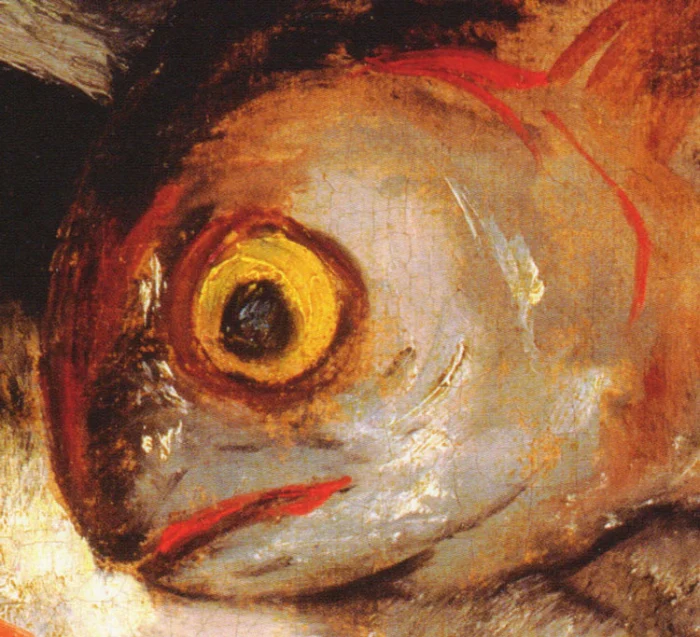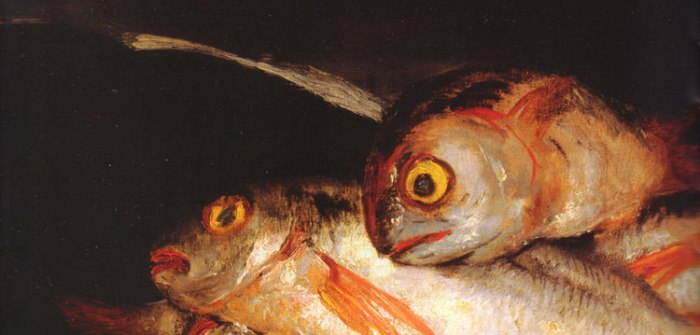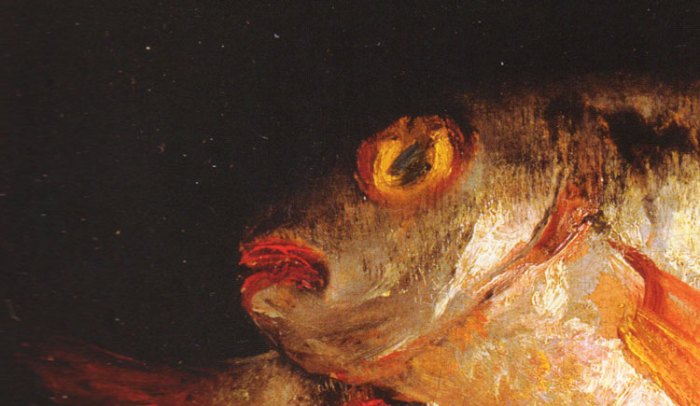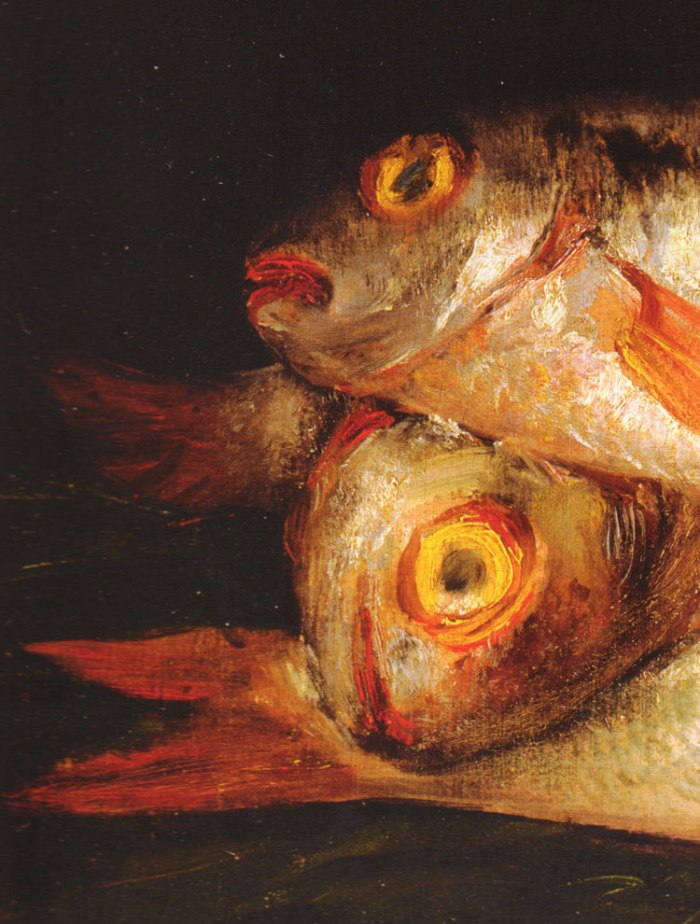Typically when I see a still life, I think, “oh look. A still life with ____”. Fill in the blank with the usual: fruit, flowers, dishes, whatever. The title of this is “Still Life with Golden Bream”, so per my usual, I’d expect to look at it and casually say, “oh look. A still life with fish.” Not quite. My first reaction is—“Oh! Are they dead?”
If not dead yet, they soon will be.
I grew up eighteen hours inland, in the Texas Panhandle. Lakes were few (and entirely man-made) and fresh seafood wasn’t on the menu at home. I didn’t see a lot of whole fish, mostly just fried catfish and previously frozen popcorn shrimp. All that to say, maybe you grew up catching your lunch in a stream or going to the wharf to buy your day’s catch. I didn’t. Whole fish, the kind that aren’t swimming around a tank with a plastic shipwreck, catch me off guard.
This painting caught me off guard. It was hanging in a fairly dimly lit room. The inky black background gives your eyes almost nowhere to look except the fish, a sliver of green in the foreground, and a bit of white that must be the crest of a wave. It is dark, but the fish are eerily lit. You can’t escape looking at the fish, lying in a pile on a green bank by the sea, reflecting moonlight off their doomed scaled bodies. And those eyes—like bullseyes. Redish orange rim surrounds yellow, punctuated by black. Big eyes staring at you. A few of the eyes aren’t looking at the viewer; instead they helplessly look up into the black abyss.
These fish are suffocating. And the black focuses us on them and that fact. There is no quaint market backdrop or pleasant far away landscape to distract us. There are no nearby goblets or vases showing off the artist’s ability to paint metallic reflections or transparent glass. Nope. Just a bunch of soon-to-be-dead fish.
In English, we call this kind of painting a “still life.” It seems pretty straightforward—a bunch of stuff from daily life, posed, still, and painted. But in French, they call it a “nature morte.” Translation: dead nature. Those paintings of flowers and fruits and plates of food are often supposed to remind us of the fleeting nature of life—they are dead. Once the fruit is picked or the flower cut, it is only a matter of time before it shrivels and dies. Often, an artist will paint the flowers as they are starting to wilt to reinforce this idea. Occasionally, you will see a human skull posed with the fruits and veggies to help make this point. Goya makes it clear with fish.
I think this work has more power because I empathize with the fish. I don’t empathize for an apple that has fallen from the tree, or a lovely rose in a vase. Those images don’t trigger that notion of impending death and decay. But, despite the fact that I enjoy eating fish, or perhaps especially because I do, seeing this pile of golden bream makes me feel a bit hopeless. I can’t go back in time to 1808 and throw Goya’s model fish back into the sea. I can’t reach into the painting and hasten their deaths to end their misery. I can’t do anything to help these six fish. I can only look and empathize.
Goya painted these fish while being surrounded by starvation due to the horrors of war. In my research, I came across this paragraph:
“Francisco de Goya painted only a dozen known still lifes, all of them in the last decades of his life. Although the subject of this work is simple—a pile of dead fish—it expresses a moving pathos reminiscent of Goya’s etching series Disasters of War, one of the artist’s great achievements. Both the print series and Still Life with Golden Bream were completed during the terrible war between Spain and France, and both serve as meditations on death and violence.” (Bowron)
Just as Anselm Keifer’s stars can stand for the holocaust of a people, I think these six fish can stand for the tragedies that Goya observed. The Disasters of War series has many images of bodies piled up, some victims of rape or slaughter, others of famine.
While being surrounded by people dying from starvation, Goya chooses to paint fish—a food source—dying of deprivation. To me, this seems like a comment on the hopelessness of the deaths due to starvation in his homeland Spain. There is water right there in the painting, all the fish need is for someone to help them back into the sea, but the fish can’t get there. Someone has intentionally separated them from the water, an essential ingredient for their survival. There are still fish in the sea—but the elements of war have intentionally cut off supply chains, separating people from food, an essential ingredient for their survival. Blockades mean the people can’t get to what they need, either. Instead, they die.
Do you empathize with the fish? What meaning do you see in this painting?
Check out this insightful post on still lifes which includes both historic background and images and some modern reinterpretations.
View all Goya’s Disasters of War here.
Bowron, Edgar Peters, and Mary G. Morton. Masterworks of European Painting: in the Museum of Fine Arts, Houston. Princeton: Princeton University Press in association with the Museum of Fine Arts, Houston. 2000. Print.














This commentary is filled with humor and power and insight in both art and humanity. I may be biased because I am kin to the author, but she made me look directly at and think about the mortality, cruelity, and the helplessness that we see in life and sometimes do nothing to stop or address. Thank you for making me laugh and cry all in one piece and sharing this work of art and bringing it to life as you helped it jump off the canvas and into my mind.
LikeLike
Ah, thanks Dad. I really enjoyed thinking and writing about this painting. I’m glad you see the complexity, too.
LikeLike
Elysia, This is King Hill, I am friend of your Father & Mother’s from my days as a teacher at Panhandle. I remember you fondly as a delightful, intelligent, curious child. I now marvel at your adult intelligence, articulate insights and maturity. Your father shared this blog entry with me and I am pleased he did. Both my wife, Dianne and I are drawn to Goya’s works. I delight in your words. Please give my best to your Mother for me and share my email address with her as well. I understand you are now a proud parent and that you and your husband have two twin boys. Dave shared a pic of them, Many congratulations and it pleases me and Dianne so much that you have become such a wonderful adult version of that young child I so enjoyed. Sincerely, King Hill
(email address removed for privacy)
LikeLike